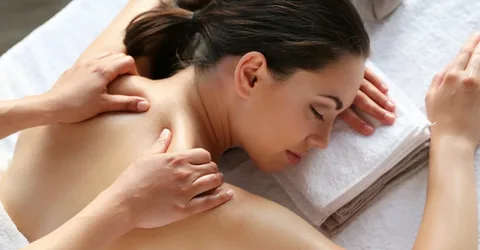In the modern, hectic society where stress takes a predominant role and sitting in front of a computer is the norm, people are looking into various means of regaining their physical and psychological balance. The art of massage body massage has now developed into an advanced therapeutic massage technique that deals with muscle tension, circulation, and psychological states. In contemporary practices within professional spheres, modern methods address a wide range of needs, and the presence of skilled professionals and their nurturing environment boosts outcomes. The cooperation between facilities and therapists guarantees efficiency and long-term positive outcomes. This paper examines the existing types of massage, the key advice on choosing a suitable service, and how to get more out of each visit to achieve longer-term wellness outcomes.
1.What is massage and why is it done?
Massage is commonly known to help alleviate pain, manage posture, and assist during the healing process after an injury or following an intensive day of exercise. Manual therapies, when practiced by clinicians, employ a diversity of procedures including long effleurage and focused deep-tissue movement as well as manipulation of the muscles’ tone, adhesions, and authoritative height. Greater local blood flow and lower levels of cortisol, better lymphatic drainage are all well-documented physiological effects of this type of treatment, and it is speculation as to why clients report both short- and long-term improvements when receiving regular treatment. When individuals desire a body massage appointment, they will usually invest in quantifiable alleviation: less soreness, more freedom of movement, and a general sense of nervous system relaxation. An intelligence evaluation before treatment makes sure that the therapist’s decisions support not just temporary feel-good or veneer relaxation, but aim to achieve a professional target.
2.Interventions and desired effects
Modern massage practice offers a range of techniques tailored to various requirements/needs. These include Swedish massage, a relaxation-focused process; deep tissue massage to alleviate chronic tension, sports massage to enhance performance and aid in rehabilitation, and trigger point massage, which targets specific areas of pain. Both approaches concentrate on differences in the pressure, rhythm, and anatomical considerations of addressing different physiological and psychological requirements. Being a good therapist will mean modulating the intensity of techniques used relative to client tolerance and the problem that presents itself, a combination of techniques at times being relevant to more individual results. Long before the day of a spa centre massage booking, expectations must be explained to a client to ensure the hustle and bustle of a session and its purpose feel more aligned with the intentions of the client in all aspects. When stress reduction or functional restoration is emphasized, the choice of modality used is a decision that is made collaboratively, with maximum benefit and minimum risk in the long run.
3.The position of testing and personalized treatment
Manual therapy and its effectiveness start with a very sound assessment that becomes the basis of the treatment methodology. The therapists obtain medical history, get them to talk about activity levels, and have functional movement checks done, such that they can establish the compensatory patterns and areas of vulnerability in the body. This stage of diagnosis guides an individualized plan which could consist of certain soft tissue work, a stretching program or referral to allied health professionals when appropriate. Repeated generic sessions can only offer temporary relief when a client is experiencing sustained discomfort; more lasting change and functional improvement are achieved when interventions are targeted to correct dysfunction and are based on assessment. Massage body massage schools with a particular strong focus on individualized assessment are more likely to provide satisfaction, retention, and lasting performance and rehabilitative gains to clients interested in rehabilitation, performance enhancements, or long-term holistic wellness.
4.Therapeutic alliance, environment, and comfort
The environmental massage treatment significantly contributes to its effectiveness, as well as satisfaction. Air-conditioned dark rooms, comfortable seats, consideration of modesty and preference to a customer can contribute to relaxation, safety, and confidence throughout the activity. In addition to physical comfort, the most fundamental is the therapeutic alliance. Transparent debate involving clarity on pressure, sensation, and boundaries influences active engagement and allows therapists to modify treatment on the fly depending on varying needs. When individuals choose to have a massage experience at a spa centre, they tend to appreciate both the shared impact of professional sensibility and trained handling; the two synergies increase both the personal sensation of calm and the objective gains in health. Health care facilities that consider other people as a priority are safe, hygienic and adopt dignified communication, which is where the healing touch works best.
5.Integrating massage with integrated wellness programmes
The most effective massage is used as a part of a larger wellness plan, including exercise, postural intervention, stress reduction, and everyday ergonomics. Home-based exercise suggestions, self-management techniques, and lifestyle guidance given by therapists ensure that clients retain between visits and avoid the recurrence of pain. Athletes may have a program of warm-ups, pre-event, and post-event body massage to quicken recovery, prevent injuries and maximize performance. Office workers can counteract the cycles of pain and stiffness by intermittently treating intermittent pain with micro-break stretching and workstation adjustment. Coordinated care facilities, or those facilities that work in conjunction with physiotherapists and movement specialists, can help clients to experience lasting change, less downtime and improved well-being instead of temporary relief.
6.Service selection and management of expectations
The proper selection of a provider implies considering credentialing, experience, and the professionalism and care standards of the facility. Clients need to ensure that the therapists in question are relevant, certified and continuing to educate themselves; disclosures concerning training and scope are good indicators of trustworthiness. The expectations also count: massage to eliminate the symptoms and enhance the performance, but not some kind of miracle cure-all. Realistic, clear goals established early, such as pain reduction, better sleep, better performance, determine how long and how often treatment should be received, and how much follow-up will be required. As you make spa centre massage reservations, individuals will also enjoy inquiring about session designation, the request to cancel, and the availability of advance intake forms or antecedent direction. Informed decisions have a greater likelihood of positive results, improved trust, and a fulfilling treatment experience, start to finish.
Conclusion
Today, massage is still an essential component of healthy care, owing to its benefits such as relaxation of muscles, promoting recovery and cutting stress in a fast-paced world. In a sensitive context, including an assessment, proper choice of the modality, an enabling ambience and improved provisions, massage is not a mere indulgence but a powerful intervention. The already engaged clients who actively interact with qualified therapists, help demystify rehabilitation expectations and select accredited centres incur the most beneficial, lasting effects. Properly applied massage body massage services and spa centre massage services support relaxation, rehab, and performance and can be an important ingredient in developing physical wellness, mental focus, and lasting emotional strength towards a balanced way of life.


